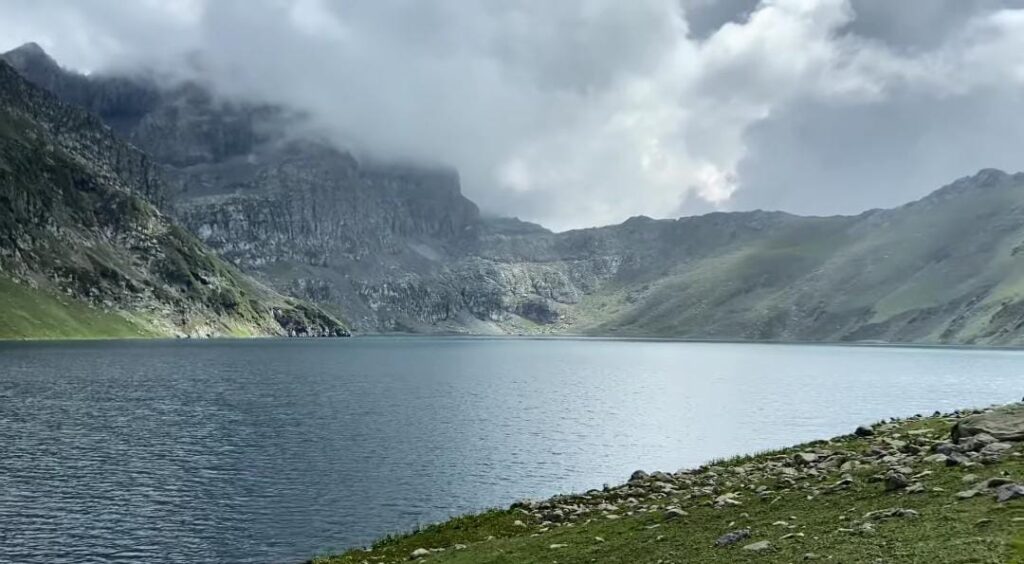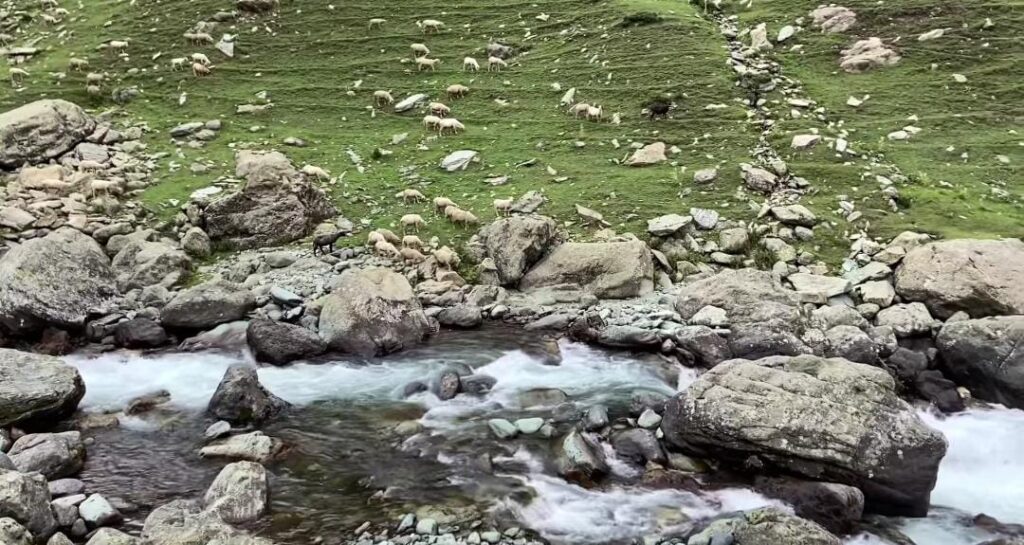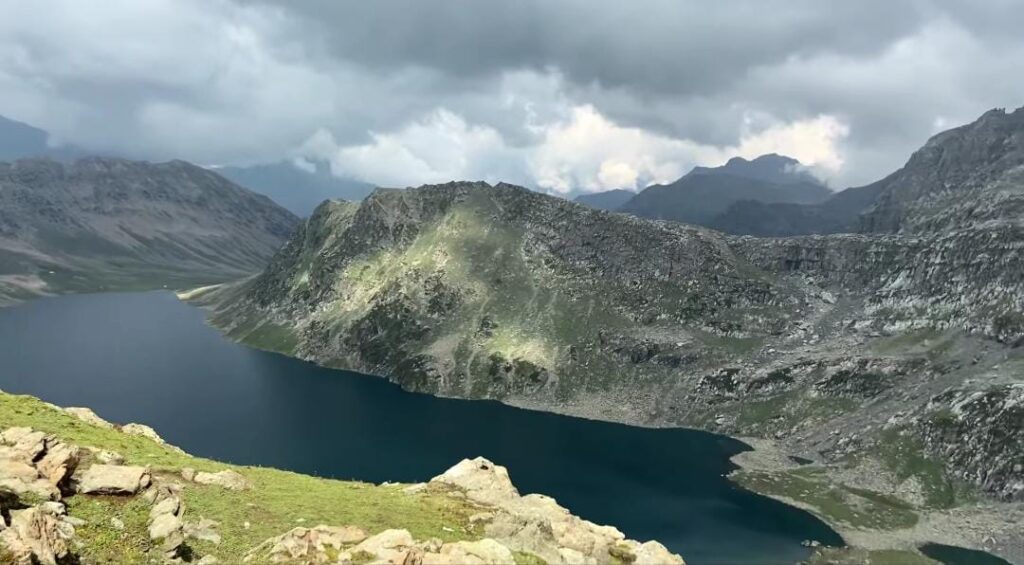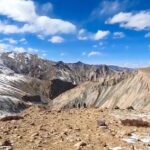


Tarsar Lake
Tarsar Lake is a stunning place in Kashmir. Start Your Journey from Aru valley, Located Approximately 110 km from Srinagar. It’s like a precious gem hidden in the huge Himalayan mountains. People who love adventure, nature, and taking pictures will find Tarsar Lake an amazing place to visit. In this blog, we will learn more about the lake, its location, and why it’s so special.
Tarsar Lake is located in the Kashmir region, which is in northern India. It’s part of the Himalayan mountains, which are some of the tallest mountains in the world. Tarsar Lake is a high-altitude alpine lake, and it’s one of two lakes in the area, with Tarsar being the bigger and more famous one. The lake is very high up, about 12,449 feet (3,794 meters) above the sea. It’s not just the lake that’s beautiful; the area around it is also amazing, with snowy peaks, green meadows, and thick pine forests making it a paradise for people who love nature.
Getting to Tarsar Lake is an adventure in itself. The most common starting point for the journey is the Aru Valley, which is about 12 kilometers from the lovely town of Pahalgam. From there, trekkers start a challenging but very rewarding journey. They hike through alpine meadows, thick forests, and steep paths. Along the way, there are peaceful streams, cozy shepherd huts, and lots of plants and animals. It’s especially beautiful in the spring and summer when wildflowers bloom everywhere.
As you go higher, the landscapes change, and you get to see even more amazing views of the mountains. Some of the big peaks you can see during the trek include Kolahoi Peak, Tatakuti/Tatakooti Peak, and Sundarsar Peak. Usually, trekkers camp at a place called Shekwas, which is a pretty meadow on the way to Tarsar Lake. The next day, they continue their journey and finally reach the shining shores of Tarsar Lake.
Tarsar Lake is famous for its clear blue waters that reflect the mountains around it, creating a mirror-like effect that’s very beautiful. The lake is surrounded by green meadows that are often covered in colorful wildflowers, making it a perfect spot for camping and picnics. During the summer, nomadic shepherds come to the lake with their sheep and goats.
The area around Tarsar Lake is home to many different animals and plants. If you’re lucky, you might see Himalayan brown bears, musk deer, marmots, and many kinds of birds. Keeping this environment clean and safe is really important to protect these natural treasures.
Cultural and Historical Importance
Tarsar Lake isn’t just a beautiful place; it also has cultural and historical significance. The nearby Shekwas and Lidder rivers are part of stories from Kashmiri folklore. A long time ago, this region was an important trade route connecting Kashmir to the rest of India.
Also, Tarsar Lake is a favorite destination for people who love adventure and nature. Many come here to challenge themselves and enjoy the peaceful Himalayan landscape. They make memories and friendships that last a lifetime.
More and more people are visiting Tarsar Lake, and that’s great, but it also means we need to take care of this special place. It’s important to be a responsible tourist. That means following rules like leaving no trash behind, camping in the right places, and respecting the local culture and environment.
Beauty of Tarsar Lake and Its Picturesque Surroundings
Tarsar Lake, tucked away in the Himalayas, is a true wonder of nature. It’s a place of incredible beauty that will leave you in awe and feeling deeply connected to the world around you. let’s dive into the breathtaking natural beauty of Tarsar Lake and the stunning scenery that surrounds it.
Crystal-Clear Waters
One of the most amazing things about Tarsar Lake is its incredibly clear water. Imagine a lake so clear that it reflects the mountains around it like a perfect mirror. When you look into the lake, you’ll see a magical blend of blues and greens that seem to dance together. It’s like something out of a dream, and it’s a dream come true for photographers.
Lush Meadows and Wildflowers
The edges of Tarsar Lake are surrounded by lush meadows that burst with life during the spring and summer. As the snow melts, these meadows come alive with a riot of colors as wildflowers bloom everywhere. The vibrant colors of these flowers contrast beautifully with the towering mountains in the background, making every step you take a visual treat.
Majestic Himalayan Peaks
Tarsar Lake is surrounded by some of the mightiest peaks of the Himalayas. These enormous mountains, like Kolahoi Peak, Tatakuti Peak, and Sundarsar Peak, create a jaw-dropping backdrop to the peaceful lake. Whether you’re a seasoned mountain climber or just someone who loves nature, the sight of these majestic peaks will stay with you forever.
Peaceful Pine Forests
The tranquility of Tarsar Lake extends to the thick pine forests that encircle it. Tall pine trees fill the air with their soothing scent, creating a calm and peaceful atmosphere. These forests are a haven for various bird species and provide a sense of solace for anyone seeking refuge in nature’s embrace.
Nomadic Shepherds and Their Flocks
In the summer, you’ll see nomadic shepherds with their sheep and goats near Tarsar Lake. This makes the place feel real and shows how people and nature can live together peacefully.
Tarsar Lake and its surroundings are a masterpiece of nature, where every little detail, from the clarity of the water to the vividness of the meadows, comes together to create a sensory experience like no other. It’s a place where nature takes center stage, inviting everyone who visits to become part of its enchanting story. As we continue our journey to explore Tarsar Lake, we’ll uncover more of its charm, from its diverse wildlife to its cultural significance.
The Amazing Geography of Tarsar Lake: Size and Special Features
Tarsar Lake, nestled in the mighty Himalayas, is a natural wonder with unique geographical features. Let’s explore the dimensions and key characteristics that make this mountain gem so special.
Size of Tarsar Lake
Height: Tarsar Lake proudly sits high up at about 12,449 feet (3,794 meters) above sea level. This lofty position not only adds to its mystique but also keeps its waters crystal clear, thanks to the melting snow from the surrounding peaks.
Surface Area: Tarsar Lake covers an area of about 1.5 square kilometers. It might not be the biggest alpine lake globally, but its stunning beauty and the connection it forges with visitors more than make up for its size.
Geological Traits
Formation: Just like many other high-altitude lakes, Tarsar Lake was born from glacial activity. Over time, ice and snow from the Himalayan peaks around it melted, creating this pristine body of water. This ancient origin gives the lake an air of timelessness.
Clear Waters: One of Tarsar Lake’s most striking features is its incredibly clear water. The lake is so transparent that it reflects the surrounding mountains like a mirror, creating a surreal and magical atmosphere. This unique characteristic sets Tarsar Lake apart from many other lakes worldwide.
Snowy Peaks: Tarsar Lake is cradled by the snow-covered peaks of the Himalayas, which both protect it and provide awe-inspiring views. Prominent peaks like Kolahoi Peak, Tatakuti Peak, and Sundarsar Peak form a majestic backdrop to the lake.
The Scenery Around
Meadows: The area around Tarsar Lake is decorated with lush meadows that burst into a riot of colors during spring and summer. These meadows offer a beautiful contrast to the lake’s clear waters and make ideal spots for camping and picnics.
Pine Forests: Thick pine forests cover the region around Tarsar Lake, enhancing its peaceful atmosphere. These forests are home to various plants and animals, adding to the area’s biodiversity.
Nomads and Livestock: In the warmer months, nomadic shepherds and their flocks of sheep and goats often visit the shores of Tarsar Lake. This interaction between people and nature adds a cultural touch to the landscape, offering a glimpse into the traditional Himalayan way of life.
Tarsar Lake’s geography, from its high elevation and clear waters to its ancient origins and the beautiful landscape around it, creates a harmonious and enchanting environment. As we continue our exploration of Tarsar Lake, we’ll uncover more of its allure, from the diverse wildlife it hosts to its cultural and historical significance.
The Importance of Tarsar Lake in the Tarsar-Marsar Twin Lakes System
Tarsar Lake, nestled in the Himalayas, isn’t alone in its beauty, it’s part of a special team with Marsar Lake called the Tarsar-Marsar twin lakes. Let’s explore why Tarsar Lake is so important in this unique two-lake system and how they work together.
The Twin Lakes Team
The Tarsar-Marsar twin lakes system has two fantastic high-up alpine lakes: Tarsar Lake and Marsar Lake. While Tarsar Lake is the bigger star, Marsar Lake is just as wonderful, and together, they make a great natural pair.
Why It Matters for Nature
Sharing Water: The most important thing about this twin lakes system is how the two lakes are connected through water. When the snow and ice melt from the big Himalayan mountains around them during summer, Tarsar Lake shares its water with Marsar Lake. This flow of fresh water helps Marsar Lake and all the life around it. It shows how these lakes need each other to survive.
Home for Nature: Both lakes and the land around them are homes for lots of plants and animals. There are different kinds of life underwater, and many birds, including those that travel a long way to visit. People who love birds and nature come here to see these special creatures and the beautiful landscape.
Why People Love It
Local Stories: These lakes are not just special for nature; they’re also part of local stories and traditions. People in Kashmir have been sharing tales and legends about these lakes for a long time, adding to the area’s rich culture.
Adventure and Hiking: The Tarsar-Marsar twin lakes system is like a dream come true for people who love adventures and hiking. The trekking trail that connects these lakes is challenging but amazing. It lets you really get into the beauty of the Himalayas and feel close to the land.
Visiting Paradise: These lakes are so wonderful that they attract tourists from all over the place. This helps the local economy and also teaches people about how important it is to take care of our natural treasures. Visitors get to experience the pure beauty of the lakes and learn why they’re so special.
In a nutshell, Tarsar Lake isn’t just beautiful on its own—it’s also part of a team with Marsar Lake, and together they do important things for nature and people. They show us how nature works and why we should protect it. These lakes, their stories, and their adventures will be cherished for a long, long time.
The Best Time to Visit Tarsar Lake and How Its Look Changes Through the Seasons
Tarsar Lake, nestled in the Himalayas, transforms throughout the year, each season giving it a different look. When you should visit depends on what you like. Let’s explore the best times to see Tarsar Lake and how it changes with the seasons.
Spring: April to June
A Colorful Show: Spring, from April to June, is a magical time at Tarsar Lake. The land wakes up from its winter nap, and the meadows burst with color as wildflowers bloom. It’s like a rainbow on the ground, with red rhododendrons and golden marigolds painting the meadows.
Nice Weather: Spring offers pleasant weather, perfect for outdoor activities. It’s not too hot or too cold, and the days are longer, giving you more time to explore. The skies are clear, so you can see the mountains well.
Summer: July to September
Green and Alive: Summer, from July to September, turns Tarsar Lake and its surroundings lush and green. Meadows are at their greenest, and dense pine forests provide shade. This is when nomadic shepherds and their sheep and goats come to the area, adding a cultural touch.
Expect Rain: But be ready for some rain in the summer. While rain can make the landscape dramatic, it can also make the trails slippery. So, bring rain gear and be cautious if you visit during monsoon season.
Autumn: October to November
Golden and Crisp: In autumn, from October to November, Tarsar Lake changes again. The meadows turn golden, and the air is cool and fresh. This is a quieter time with fewer trekkers around.
Clear Views: Autumn gives you some of the clearest views of the mountains. The sky is usually very clear, making it great for taking beautiful mountain photos.
Winter: December to March
Frozen Beauty: Winter, from December to March, covers Tarsar Lake in a thick blanket of snow and ice. The lake often freezes, creating a magical winter scene. If you’re up for an adventure, visiting during winter can be a unique and peaceful experience.
Extreme Cold: But remember, winter visits are not easy. It’s very, very cold, and trekking can be tough. You’ll need the right gear and experience in winter trekking to enjoy it safely.
Tarsar Lake changes its look with the seasons. Spring is colorful and comfortable, summer is green and wet, autumn is golden and quiet, and winter is a frozen wonderland. Choose the time that suits you best and get ready for a fantastic experience in the Himalayas!
conclusion
As our virtual journey to Tarsar Lake in the Himalayas comes to an end, we say a warm farewell to a place of unmatched beauty and charm. Tarsar Lake, with its clear waters, green meadows, and tall peaks, is a true wonder of nature. In this heartfelt conclusion, let’s recap the enchanting beauty and timeless allure of Tarsar Lake.
A Pristine Gem: Tarsar Lake is like a precious gem nestled in the heart of the Himalayas. Its glistening waters perfectly mirror the snowy mountains that surround it, creating a breathtaking sight. The lake’s crystal-clear waters invite us to connect with nature and find peace within ourselves.
Changing Seasons: Tarsar Lake is a place where nature showcases its artistry through the changing seasons. In spring, colorful wildflowers carpet the meadows, while summer brings lush greenery. Autumn paints the landscape in golden hues, and winter drapes it in a serene snowy blanket. Each season offers a fresh perspective on its beauty.
High-Altitude Adventures: The journey to Tarsar Lake is not just a physical trek; it’s a soul-stirring adventure. Climbing through meadows, forests, and challenging terrain, trekkers are rewarded with awe-inspiring views at every step. The journey itself reminds us of our strength and the thrill of exploration.
Cultural Significance: Tarsar Lake isn’t just a natural wonder; it’s also steeped in the culture and traditions of the Kashmiri people. It’s a place where stories have been told for generations, where nomadic shepherds find refuge, and where trekkers create their own tales of discovery.
Preservation and Responsibility: As we bid farewell to Tarsar Lake, we carry with us a deep sense of responsibility. We must protect and preserve natural treasures like Tarsar Lake for future generations to enjoy. Responsible tourism and environmental conservation are essential to ensure that places like this continue to enchant the world.
In the end, Tarsar Lake isn’t just a destination; it’s an experience that leaves a lasting impression on our hearts. It’s a place where nature’s beauty reigns supreme, where the might of the Himalayas humbles us, and where our hearts find solace in the mountains’ tranquility.
As we say goodbye to Tarsar Lake, let us carry its beauty and magic in our hearts. It will forever remain a symbol of the wonder of the natural world and a call to those who seek to explore its mysteries. Until we meet again, Tarsar Lake, you will always hold a special place in our memories and dreams, inviting us to return to your serene shores.
Discover the Magic of Kashmir’s Natural Beauty in Our New Blog – An Adventure You Can’t Miss! Gulmarg , Dal Lake , Pahalgam , Tulip Garden , Doodhpathri Kashmir





